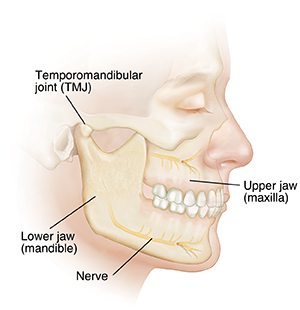Understanding Jaw (Orthognathic) Anatomy and Problems
A jaw that’s too small, too large, or crooked can cause problems with chewing, speaking, breathing, and even sleeping. The shape of your jaws also affects the way your face looks. This sheet helps you understand how the teeth and jaws work. It also describes common jaw problems that may need treatment.
How bones and teeth shape the face
Bones are the framework for the face. The size and position of facial bones determine how well the teeth fit together. Together, the positions of the jaws and teeth affect chewing, speaking, and the working of the jaw joint. The jaws also hold and support soft tissues, like the muscles, lips, and tongue. And, of course, the jaws and teeth are factors in the face’s shape and appearance.
-
The temporomandibular joints (TMJs) allow the lower jaw to move smoothly.
-
The lower jaw (mandible) supports the bottom row of teeth and gives shape to the lower face and chin. This is the bone that moves as the mouth opens and closes.
-
The upper jaw (maxilla) holds the upper teeth, shapes the middle of the face, and supports the nose.
-
A good bite (occlusion) means that the upper and lower teeth are straight and fit together properly.

How the jaws work
The lower jaw holds the tongue, which moves freely as you speak and eat. The upper jaw shapes the floor of the nasal cavity, allowing normal airflow. Muscles usually are evenly developed on both sides of the face.
Common problems
Some common jaw alignment problems are described below. It’s also common to have a combination of these problems.
-
Lower jaw is too far back. When the lower jaw is too far back (retrognathia), biting can be difficult. The chin appears weak or receding.
-
Lower jaw is too far forward. A lower jaw that is too far forward (prognathia) causes the chin to protrude. Lower teeth may jut outward to overlap the upper teeth.
-
Teeth don’t meet (open bite). An open bite is often due to a long upper jaw. This can cause a gummy smile. Or the problem may be that the rear of the lower jaw is too short. An open bite can also be caused by prolonged thumb sucking or improper tongue position at rest and when swallowing. An open bite can make it impossible to close the lips.
-
Jaws are uneven (asymmetry). Uneven jaws are larger or smaller on one side than on the other. Or 1 side may be too far forward or back. The face may look off-center or crooked.
When jaws are not aligned
Poorly aligned jaws can result in a variety of problems, including:
-
Chewing problems. You may find it difficult to bite into a sandwich or an apple, or difficult to keep food in your mouth as you chew. The TMJs may be stiff or painful.
-
Speech problems. It may be difficult to make certain sounds or to speak clearly.
-
Breathing problems. If the airway is narrow or blocked, breathing may be noisy or difficult. You may have sleep apnea (breathing that repeatedly stops and starts during sleep).
-
Problems with appearance. You may be unhappy with the way you look. This can make you self-conscious and may affect your confidence.